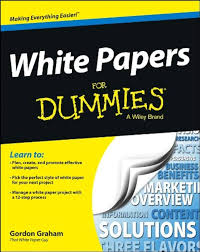White Papers for Dummies: A Comprehensive Guide
Introduction
White papers are in-depth reports or guides that inform readers about a complex issue and present facts and research to support an idea or solution. They’re often used in business to educate potential customers, generate leads, and establish thought leadership.
Understanding the Basics
- Purpose: White papers aim to inform, persuade, and educate. They should provide value to the reader, not just promote a product or service.
- Structure: A typical white paper includes an executive summary, introduction, body, conclusion, and references.
- Tone: The tone should be authoritative, informative, and objective. Avoid using overly promotional language.
- Format: White papers are typically formatted as long-form articles or PDF documents.
Types of White Papers
- Product White Paper: Highlights the features and benefits of a specific product or service.
- Industry Analysis White Paper: Provides an in-depth analysis of a particular industry, including market trends, challenges, and opportunities.
- Problem/Solution White Paper: Identifies a problem and presents a solution, often highlighting the author's product or service as the answer.
- Thought Leadership White Paper: Positions the author as an expert in a particular field by sharing insights and original research.
Writing Your White Paper
- Define Your Audience: Understand your target audience's knowledge level, interests, and pain points.
- Develop a Strong Thesis: Clearly state the main argument or point you want to make.
- Conduct Thorough Research: Gather credible sources to support your claims.
- Create a Compelling Outline: Organize your content logically and ensure a smooth flow.
- Write Clear and Concise Copy: Use simple language and avoid jargon.
- Use Visual Aids: Incorporate charts, graphs, and infographics to enhance understanding.
- Edit Rigorously: Proofread carefully to eliminate errors in grammar, punctuation, and spelling.
Promoting Your White Paper
- Share on Social Media: Use relevant hashtags and engage with your audience.
- Email Marketing: Send targeted emails to your subscriber list.
- Guest Posting: Contribute to industry blogs and publications.
- Optimize for Search Engines: Use relevant keywords and meta descriptions.
Additional Tips
- Keep it Scannable: Use headings, subheadings, and bullet points.
- Cite Your Sources: Reference your sources to build credibility.
- Use a Strong Call to Action: Encourage readers to take the next step, whether it's contacting your company or downloading another resource.
Mastering the Art of Copywriting: A Deep Dive
To enhance your white paper's impact, consider incorporating the principles of effective copywriting. Alan Sharpe's video course on copywriting offers invaluable insights into crafting persuasive and engaging content. Key takeaways from his course include:
- Understanding Your Audience: Tailor your message to resonate with your target audience's needs and desires.
- Writing Compelling Headlines: Grab attention with strong, benefit-driven headlines.
- Using Persuasive Language: Employ powerful words and phrases to evoke emotions and drive action.
- Crafting a Strong Call to Action: Clearly state what you want the reader to do.
- Testing and Refining: Continuously test and refine your copy to maximize its effectiveness.
Conclusion
By following these guidelines and incorporating the principles of effective copywriting, you can create white papers that inform, persuade, and drive results. Remember, a well-crafted white paper is a valuable tool for establishing thought leadership and generating leads for your business.
References:
- White Papers For Dummies by Gordon Graham
- Alan Sharpe's Copywriting Course (Online Course)
Note: To access Alan Sharpe's video course, you may need to enroll in his program or search for relevant online resources.



